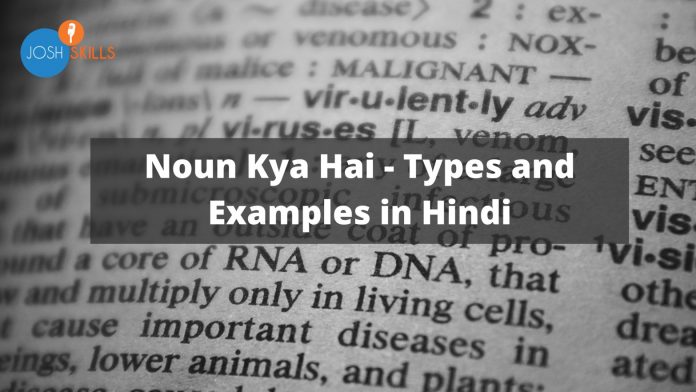
Aaj hum focus karenge ke Noun kya hai, ye kitne prakar ke hote hai aur is ke examples kya hai. Aap sab to jaante hi hai ke English ek aisi language hai jo har jagah boli jaati hai. Kayi log English bol paate hai lekin wo usme poori tarah comfortable nahi hote aur unhe ye dar zarur laga hota hai ke kahin wo jo English me bol rahe hai ya likh rahe hai woh correct hai ke nahi.
Kya aap ne kabhi notice kiya hai ke is dar ko kaise bhagaya jaaye aur apni English ko kaise perfect banaya jaaye. Chaliye hum aapko batate hai.
English Me Perfection Ke Liye Seekhiye English Grammar
English ko seekhne ke liye sab se pehle aapko English Grammar sahi tarah se seekhni hogi, toh chaliye hum josh talks ke madhyam se aap ki English Grammar ko perfect banane me aapki help karte hai.
Aap ne ye notice kiya hoga ke jab bhi aap English Grammar seekhna start karte hai to sab se pehle ye sikhaya jata hai ke “Noun Kya Hai” Ya “Noun Kya Hota Hai” kyunki Noun English Grammar ka foundation hai.
Toh aaiye sikhte hai Noun in Hindi – Meaning, Examples and Types.
Josh Skills App par Sikhe Fluent English Bolna
Jaante Hai Noun In Hindi Kya Hai? Ya Noun kise kehte hai?
Noun word bana hai ek Latin word “Nomen” se, jiska English me meaning hai “Name” aur isey Hindi me kaha jata hai “Sangya”.
Agar samajhne ke nazariye se dekha jaye to Noun wo word hai jo kisi person, place, animal ya kisi cheez, kisi feeling, quality aur ideas ko identify karta hai.
Noun In Hindi: Examples
- Person: Aadmi, Aurat, John, Mary etc
- Place: America, London, Ghar, Office etc
- Animal: Dog, Cat, Monkey etc
- Thing: Table, Chair, Building, Banana etc
- Feeling: Hot, Cold, Joy, Fear etc
- Quality: Beauty, Ugly, Strong etc
- Ideas: Hope, Joy etc
Jaante Hai Definition Of Noun In Hindi
Noun kya hai? Noun wo hai jo kisi specific object ya set of objects, jaise ke living creatures, jagah, actions, qualities ya state of existence ya ideas ko darshata hai.
Noun ke examples in Hindi:
- John khel raha hai – John is playing (Person ka naam)
- Mai Australia me rehta hu – I live in Australia (Jagah ka naam)
- Mujhe meri Cat ke saath khelna accha lagta hai – I like to play with my Cat (Animal ka naam)
- Mujhe Garmi lag rahi hai – I Feel Hot (Feeling)
- Mujhe asha hai ke mai class me first aaungi – I hope I will be first in class. (Idea)
Kisi Bhi Sentence Me Noun Ko Pehchaniye Yani Ke How To Recognize A Noun?
Aap soch rahe honge ke kisi bhi sentence me Noun ko kaise pehchane. Dekhte hai iske tarike:
- Ending
- Position
- Function
1. Noun Ko Pehchanne Ka Pehla Prakar – Noun Ending
Noun kya hai jaanne ke baad ab seekhenge ke Noun ko kaise pehchana jaye. Kuch words aise hote hai jiske ending ke alphabets ye batate hai ke wo word Noun hai.
Nouns Verbs, Adjectives ya dusre Nouns se bhi bante hai.
Noun, Verbs ya Adjectives ke end mai suffix lagane se Nouns bante hai.
Ab Aap Soch Rahe Honge Ke Suffix Kya Hai?

Suffix wo letters ya group of letters hai jo word ke end mai yani ke theek end ke baad add kiye jate hai. Ye word ke meaning ko change karne ke liye use hote hai. Suffixes add karne ka specific rule nahi hai lekin iske patterns hai.
Adjectives aur verbs ko bhi Noun mai change kiya ja sakta hai.
Chaliye aap ki understanding ke liye hum aapko bata dete hai ki Adjectives aur Verbs kya hai.
Adjective Kya Hote Hai?
Adjective wo word hai jo Noun ko modify karne keliye use hota hai taake usko aur specific banaya jaye. Example: A red rose.
Is sentence mai “red” adjective hai.Yahan rose jo Noun hai us ko specific tarah se bataya ja raha hai ki wo “red” hai.
Verb Kya Hote Hai?
Verb wo word hai jo kisi bhi action, state ya occurrence ko darshata hai. Jaise ke hear, become, happen etc.
Ab aap samajh gaye honge ke Adjective aur Verb kya hai. Chaliye aage badhte hai aur iske patterns dekhte hai.
Isse pehle ke hum aage badhe hum aap ko batate hai ki English se related sabhi jaankaari jaise ke English Grammar, English me bolna seekhna aur bahut saari important information aap ko josh skills par mil jayegi.
a) Adjectives Se Nouns Banane Ke Liye Aap “- ness” Add Kar Sakte Hai
First pattern mai apko ye note karna hai ki sabhi adjectives ko “-ness” nahi lagaya ja sakta lekin ye ek common form hai un adjectives ke liye jo “y” se end hote hai aur word ki spelling jo “y” se end hoti hai wo “i” me change ho jayegi aur uske saath “- ness” lagaya jayega.
Hard consonant sounds jaise ke d, t etc in ending letters ka suffix hoga “ful”.
Aaiye iske examples dekhte hai:
- Ready – They questioned her readiness for the test. Yahan par ready ka “y” convert ho chuka hai “i” me aur us ka suffix ho gaya hai “ness” toh ready ban gaya hai readiness.
- Happy – It is important to create happiness for everyone.
- Mad – The decision to drive in the snow was pure madness.
- Forgetful – Forgetfulness comes with old age.
b) Adjectives Se Nouns Banane Ke Liye Aap “- ity” Add Kar Sakte Hai.
Second pattern mai “-ity” un Adjectives ke liye use kiya jata hai jo “-ble” ya soft sounds jaise ke “s” se end hote hai. Is mai word ke ending ki spelling bhi change hoti hai.
Example:
- Responsible – Your children are not my responsibility. Yahan par responsible word ke ending me “ble” hai wo change ho raha hai “bility” mai
- Possible – Nuclear was seemed like a real possibility.
- Scarce – There is scarcity of water in this building.
- Hilarious – They reacted to the joke with much hilarity
c) Adjectives Aur Verbs Se Nouns Banane Ke Liye Aap “- ance” And “-ence” Add Kar Sakte Hai.
Example:
- Independent – Having a car improved my independence. Is sentence mai last letter “t” convert ho gaya hai “ce” mai isiliye independent ban gaya hai independence.
- Important – Never underestimate the importance of studying.
- Appear – The appearance of the second singer improved the concert.
d) Adjectives Or Verbs Se Nouns Banane Ke Liye Aap “-ment” Add Kar Sakte Hai.
Fourth pattern ye hai ke, ye usually use hota hai un adjectives ke liye jo “y” se end hote hai. Ye suffix word ki core spelling ko change nahi karte. Lekin “y” “i” me change hojayega.
Example:
- Appoint – I need to make an appointment with my doctor.
- Assign – The final essay was a big assignment.
- Merry – The children found a lot of merriment in clown’s antics. Is sentence mai “Merry” ka last letter jo “y” hai wo convert ho gaya hai “i” me aur suffix add ho gaya hai “ment”
e) Verbs Se Nouns Banane Ke Liye Aap “- tion” And “- sion” Add Kar Sakte Hai.
Fifth pattern ye hai ki ye suffixes kayi verb forms ko follow karte hai, aur kayi baar apni spelling bhi change kar dete hai sentence me comfortably fit hone ke liye. Jaise ke: ek additional vowel add karna ya consonant ko change karna.
Example:
- Inform – There is not much information available about foxes in our country.
- Decide – The committee will make a formal decision this friday.
- Describe – The police have a good description of the thief.
- Admit – The criminal’s admission of the guilt got him in trouble.
f) Nouns Se Nouns Banane Ke Liye Aap “-ship” And “- hood” Add Kar Sakte Hai.
Sixth pattern ye hai ki, Nouns me agar word ke end me “-ship” added ho to wo Abstract Noun ban jata hai jo ke Noun ki relationship batata hai. Jaise ke word relationship hi is ka example hai.
- Friend – Our friendship is very strong.
- Partner – We are in partnership with a major organisation.
Nouns me agar “- hood”, word ke end me add kiya jaye to wo Abstract Noun ban jata hai jo groupings ko darshata hai. Ye logon ke groups ke liye ya areas or period of time ke liye use kiya jata hai.
Example:
- Priest – Entering the priesthood is a very serious commitment.
- Neighbour – Our neighbourhood is thankfully very quiet.
- Child – My childhood was a fun and productive time!
Aap Adjectives aur Verbs ke bare mai detail me jankari pa sakte hai josh talks ki site par.
2. Noun Ko Pehchanne Ka Dusra Prakar – Noun Position
Kisi bhi sentence me Noun ki jo position hoti hai usse bhi hum Noun ko jaan sakte hai. Noun hamesha a, an, the, this, my, such ke baad hi aata hai.
Noun ki position ko batane wale examples janiye:
- A relief
- An Afternoon
- The Doctor
- This Word
- My House
- Such Stupidity
Noun ek ya ek se zyada Adjectives ke baad bhi aata hai.
Adjective ke baad aane wale Noun ke examples janiye:
- A great Relief
- A peaceful Afternoon
- The tall, Indian Doctor
- This difficult word
- My brown and white house
- Such crass stupidity
3. Noun Ko Pehchanne ka Teesra Prakar – Noun Function
Nouns ke kuch certain functions ya jobs hote hai sentence mai.
Aaiye iske kuch examples dekhte hai.
- Doctors work hard – Doctors hard work karte hai.
- He likes coffee – Usko coffee pasand hai
- Teachers teach students – Teachers students ko padhate hai
Noun Kitne Prakar Ke Hote Hai? Ya, Noun Ke Prakar Kya Hai?
Aap ye to samajh hi gaye honge ke Noun in Hindi kya hai, ab hum aage badhte hai aur aapko batate hai ke types of Nouns jise hum Noun ke prakar bhi kehte hai wo kitne hai and English aur Hindi dono language me wo kis naam se jaane jate hai.
Nouns ke prakar barah hote hai. Aaiye dekhte hai types of Nouns in Hindi and English language.
- Proper Noun – Sangya Vishesh
- Common Noun – Jativachak Sangya
- Collective Noun – Samuh Vachak Sangya
- Possessive Noun – Swat Atmak Sangya
- Number Noun – Vachan Sangya
- Compound Noun – Yougik Sangya
- Countable Noun – Gananiya Sangya
- Uncountable Noun – Agananiya Sangya
- Concrete Noun – Thos Sangya
- Abstract Noun – Bhav Vachak Sangya
- Gender Noun – Ling Sangya
- Material Noun – Samagri Sangya
Chaliye Nouns ke prakar ko jaante hai detail mai.
1. Proper Noun – Sangya Vishesh, Noun In Hindi Ka First Prakar
Kisi bhi vyakti ka naam jaise ke aapka naam ya aapke parents ka naam ya kisi aur ka naam, kisi place ka ya country ka naam, week days aur months ke naam, festivals ya kisi special din ke naam, kisi building ka naam, mountains ke naam ya nadi aur seas ke naam ko special naming words ya Proper Noun kehte hai.
Ab aapko ye note karna hai ke ye naam hamesha capital letter se shuru hote hai.
Proper Noun in Hindi ke kuch examples:
- My name is Mark – Mera naam Mark hai
- Her name is Mary – Uska naam Mary hai
- Come Tom, let us go for a walk – Chalo Tom, walk pe chalte hai
- Hello Jack, will you play with me? – Hello Jack, kya tum mere saath kheloge?
- My cousin lives in New Zealand – Mera cousin New Zealand me rehta hai
- These Tigers are from India – Ye Tigers India se hai
- Simon was born in Argentina – Simon ka janam Argentina me hua tha
- I visited the Tajmahal in India – Mai ne Tajmahal ke darshan kiye India mai
- Diwali is my favorite festival – Diwali meri favourite festival hai
- We will meet on Independence Day – Hum Independence Day per milenge
- I have seen Great Wall of China – Maine Great Wall of China dekhi hai
- Many people had visited the Himalayas – Kai logon ne Himalayas visit kiya hai
Badhte hai Common Noun yani Jati Vachak Sangya ki oar.
2. Common Noun – Jativachak Sangya, Noun In Hindi Ka Second Prakar
Common Noun wo hai jo log, places, things aur animals etc ke liye common hai. Ye Nouns kisi particular place, animal ya thing ko define nahi karte. Yeh general naam hote hai.
Isi liye in ka first alphabet capital me nahi likha jayega jab tak ke wo sentence ki shuruaat yani ke sentence ko start na kar rahe ho. Jaise ke boy, girl, city, car, doctor, town etc.
Common Noun ke kuch examples dekhte hai
- Teachers teach in school – Teachers school me shiksha dete hai
- Birds live on trees – Chidiya ped par rehti hai
- I love to read storybooks – Mujhe storybooks padhna pasand hai
- Samuel’s mother is a doctor – Samuel ki mother doctor hai
- Ab to aap jaan gaye honge ke Proper Noun aur Common Noun kya hai. Chaliye thodi si practice ho jaye.
- Isse hum jo aapko Common Noun in Hindi aur Proper Noun in Hindi samjha rahe hai aap us me perfection pa sakte hai.
Neeche diye gaye sentences me Proper Noun aur Common Noun pehchaniye
- Sandy is joining school today – Sandy aaj school join kar raha hai. Is sentence mai Sandy Proper Noun hai aur school Common Noun hai
- Sam and Tom were playing with a ball – Sam aur Tom, ball se khel rahe they. Is sentence mai Sam aur Tom Proper Noun hai aur ball Common Noun hai.
- Birds have laid eggs on Rohan’s bag – Birds ne Rohan ke bag pe ande diye hai. Is sentence mai Birds Common Noun hai aur Rohan Proper Noun hai.
- The postman Mr. Rohit was carrying postcards – Postman Mr. Rohit Postcards carry kar rahe hai. Is sentence mai postman Common Noun hai aur Mr. Rohit Proper Noun hai. Ab aage badhte hai Collective Noun in Hindi ki taraf.
3. Collective Noun – Samuh Vachak Sangya Noun Ka Third Prakar
Collective Nouns kisi group ko address karne ke liye use kiye jaate hai. Jaise ke kisi person ya jagah, kisi animal ya things ke group ko jis naam se bulaya jata hai us ko Collective Noun kehte hai.
Collective Noun meaning in Hindi to aap samajh hi chuke honge. Ab iske kuch examples dekhte hai.
Animals Aur Birds Ke Liye
Collective Noun, animals aur birds ke group ke liye use kiye jane wale examples ye hai.
- A flock of sheep – Bakron ka jhund
- A pack of wolves – Bhediyon ka jhund
- A shoal of fish – Machli ka ek thaal
Logon Ke Group Ke Liye
Collective Noun, logon ke group ke liye use kiye jane wale examples ye hai.
- A crew of sailors – Naavikon ka dal
- An army of soldiers – Sainikon ki sena
- A band of musicians – Sangeetkar ka ek band
Cheezon Ke Group Ke Liye
Collective Noun, things yani cheezon ke group ke liye use kiye jane wale examples ye hai.
- A bunch of keys – Chaabiyon ka guccha
- A string of pearls – Motiyon ki ladi
- A set of stamps – Stamps ka set
Ab hum aapko batayenge ke Collective Noun ko sentences me kaise use kiya jata hai.
Dekhiye Common Noun in Hindi ke kuch examples
- I bought a pair of tennis shoes – Mai ne apne liye tennis shoes ki ek jodi li hai
- You observe a colony of ants – Aap cheentiyon ki basti dekhiye
- A pile of clothes was kept on the bed – Bed par kapdon ka dher hai
Aage badhte hai Possessive Noun ki taraf
4. Possessive Noun – Swat Atmak Sangya, Noun Ka Fourth Prakar
Aaiye dekhte hai Possessive Noun jo ke Noun ke prakar me se ek hai. Possessive Noun us word ko kaha jata hai jo batata hai ki kon ya kiske paas kya cheez hai. Yahan par Possessive Noun ko banane ke liye hum Singular Noun ko apostrophe aur s (‘s) lagate hai.
Aaiye Possessive Noun ke kuch examples dekhte hai
- This is Bob’s skateboard – Ye Bob ka skateboard hai. Is sentence mai hame bataya ja raha hai ke ye skateboard Bob ka hai
- This is Sam’s coat – Ye coat Sam ka hai. Is sentence mai bataya gaya hai ke ye coat Sam ka hai
- Julia’s homework was not checked – Julia ka home work check nahi kiya gaya. Is sentence me bataya gaya hai ke Julia ka homework check nahi hua hai.
Ye jo examples aap dekh chuke hai wo Singular Noun ke hai. Ab aage badhte hai aur dekhte hai ke Plural Nouns yani wo word jo ek se adhik ke liye use hota hai, uske liye Possessive Noun kaise use kiya jayega.
- A boys’ school is located near my house – Ladkon ka school mere ghar ke paas hai. Is sentence mai kisi ek ladke ko address nahi kiya ja raha hai balke saare ladkon ko point out kar rahe hai.
- We should not harm the animals – Hume janwaron ko harm nahi karna chahiye. Is sentence me hum kisi ek animal ko point out nahi kar rahe hai balke saare animals ko address kar rahe hai.
Hamare dwara di gayi Possessive Noun in Hindi ki jaankari se aap samajh gaye honge ke Possessive Noun kya hai aur ise kis tarah sentence me use kiya jata hai.
5. Number Noun – Vachan Sangya, Noun In Hindi Ka Fifth Prakar
Aaiye dekhte hai Number Noun jo ke ek Noun ke prakar hai wo kya hai. Number Noun wo word hai jo aap ko ye batata hai ke aap jiske bhi baare me baat kar rahe hai wo count me ek hai ya ek se adhik hai.

Types of Number Noun. Number Noun do types ke hote hai
Singular Number Noun
Plural Number Noun
Singular Number Noun jise Hindi mai kaha jata hai Ek Vachan Sangya.
Plural Number Noun jise Hindi mai kaha jata hai Bahu Vachan Sangya.
Jaise ke: One toy, three balls, five pens, saath ladke etc
Agar hum Singular Noun ke peeche “s” lagate hai to hum use Plural Noun bana sakte hai. Lekin iskeliye hume kuch rules follow karne ki zarurat hai. Aaiye dekhte hai wo rules konse hai.
Rule – 1
Jab ek Singular Noun consonant ke baad “Y” se end hota hai, hum us word mai se “Y” nikaal dete hai aur “Y” ki place par “ies” laga dete hai.
Example:
- City – Cities
- Lady – Ladies
- Story – Stories
Ab aap sonch rahe honge ke consonant kya hai? Consonants me saare alphabets include hote hai sirf vowels jo hai (a,e,i,o,u) include nahi hote.
Rule – 2
Agar kisi word ke end me “Y” se pehle vowel hai toh, sirf “Y” ke baad “S” lagane se wo plural ban jayega.
Example:
- Boy – Boys
- Days – Days
- Toy – Toys
Rule – 3
Agar koi Singular Noun “O” se end ho raha hai aur usse pehle vowel hai to word ke end me “O” ke baad “S” lagane se wo plural ban jayega.
Example:
- Video – Videos
- Bamboo – Bamboos
- Radio – Radios
Rule – 4
Agar koi Singular Noun “O” se end ho raha hai aur us se pehle consonant hai toh “O” ke baad “ES” add karne se wo plural ban jayega.
Example:
- Hero – Heroes
- Tomato – Tomatoes
- Volcano – Volcanoes
Is mai note karne wali baat ye hai ke kuch Nouns jo “O” se end ho rahe hai aur “O” se pehle consonant hai toh sirf “S” lagane se wo plural ban jayega.
Example:
- Photo – Photos
- Piano – Pianos
Rule – 5
Agar koi Singular Noun “S”, “SS”, “SH”, “CH”, “X”, “Z”, “TCH” toh hame inhe plural banane ke liye “ES” add karna chahiye.
Example:
- Dress – Dresses
- Box – Boxes
- Quiz – Quizzes
Rule – 6
Agar koi Singular Noun “F” ya “FE” se end hota hai toh hame chahiye ke hum “F” ko “V” me badlein aur “V” ke aagey “ES” lagaye, aisa karne se wo Singular Noun plural ho jayega.
Example:
- Knife – Knives
- Wolf – Wolves
- Calf – Calves
Irregular Plural
Kuch Nouns ke plurals same hi reh jaate hai. Inke singular form aur plural form me koi change nahi aata, wo same hi rehte hai.
Example:
- Cattle – Cattle
- Sheep – Sheep
- Deer – Deer
Hum ko ye bhi note me laana hai ke kuch Nouns ke plurals unke singular form se bilkul bhi match nahi karte, wo bilkul alag hote hai.
Example:
- Child – Children
- Mouse – Mice
- Ox – Oxen
Aur kuch Nouns aise bhi hote hai ke wo hamesha plural form me hi hote hai jaise ke pants, jeans, sunglasses etc.
Badhte hai Compound Noun ki taraf aur dekhte hai Compound Noun meaning in Hindi
6. Compound Noun – Yougik Sangya, Noun In Hindi Ka Sixth Prakar
Compound Nouns jo ke Noun ke prakar me se ek hai wo two words ko join karne se bante hai. Usually Compound Nouns [Noun + Noun] ya [Adjective + Noun] hote hai.
Har Compound Noun single unit ki tarah kaam karta hai aur ye adjectives ya Nouns ke through modify kiya ja sakta hai.
Compound Noun ko form karne ke teen tarike hai. Aaiye dekhte hai wo kya hai
Open or Spaced – Is mai dono words ke beech me place hoti hai. Jaise ke (Bus Stop). Yahan par bus aur stop ke beech me space hai.
Hyphenated – Is mai dono words ke beech hyphen hota hai. Jaise ke (Father-in-law). Yahan words ke beech hyphen hai.
Closed or Solid – Is mai dono words ke beech na to space rahegi na hi hyphen. Jaise ke (Football).
Chaliye dekhte hai examples of Compound Noun in Hindi
- It was going to be lunchtime – Lunchtime hone wala tha (Closed or Solid)
- Can we use the swimming pool? – Kya hum swimming pool use kar sakte hai? (Open or Spaced)
- We need to take x-ray today – Humko aaj x-ray lena hai (Hyphenated)
7. Countable Noun – Gananiya Sangya, Noun In Hindi Ka Seventh Prakar
Countable Noun, Noun ke prakar me se ek hai, Jin Nouns ko hum count kar sakte hai unhe Countable Nouns kaha jata hai. Zyada tar Nouns countable hote hai kyonki wo things, people ya animals ko refer karte hai jo ke countable hote hai.
Countable Nouns ke kuch examples dekhte hai
- I have only two dollars – Mere paas sirf do dollars hai
- To make this cake we need an egg – Is cake ko banane ke liye hame ek ande ki zarurat hai.
Kuch singular Nouns unique hote hai jin ke pehle hum “The” lagate hai.
Jaise ke
- The sun
- The moon
- The earth
8. Uncountable Noun – Agananiya Sangya, Noun In Hindi Ka Eight Prakar
Jin Nouns ko hum count nahi kar sakte unhe hum Uncountable Nouns kehte hai. Uncountable Nouns ko hum “Mass Noun” bhi kehte hai.
Kuch cheezon ko hum count nahi kar sakte, jaise ke milk, paani, sugar, jam etc. Iskeliye hame kuch aur words ki zarurat hoti hai jaise ke
- A glass of milk – Doodh ka glass
- A jar of sugar – Sugar ka jar
- A bottle of jam – Jam ka bottle
Hum Uncountable Nouns ke saath is prakar ke terms use kar sakte hai jaise ke a little, plenty, a bowl of, etc. Ye measure to kiye ja sakte hai lekin count nahi kiye ja sakte. Aise Nouns na to singular maane jaate hai na hi plural.
9. Concrete Noun – Thos Sangya, Noun In Hindi Ka Ninth Prakar

Samajhte hai Concrete Noun Hindi mai.
Noun ke prakar me se Concrete Noun bhi ek prakar hai. Aap to jante hi honge ke hamare paas five senses hote hai, jo hai: Sight, Hearing, Speaking, Tasting,Touching. In five senses se hum jis bhi person, place ya thing ko experience kar sakte hai unhe kaha jata hai Concrete Noun.
Jo cheezein aap dekh nahi sakte ya smell nahi kar sakte ya taste nahi karsakte ya touch nahi kar sakte wo Concrete Noun nahi kehlaye jayenge.
Agar aap apne surroundings me dekhe to aap ko kayi saare concrete Nouns ke examples mil jayenge.
Chaliye hum aap ko concrete Noun in Hindi ke kuch examples batate hai
- Have you met James Bond? – Kya aap James bond se mile hai? Is sentence me James bond naam ke person se milne ki baat batayi ja rahi hai, Jame bond ko hum dekh sakte hai, sun sakte hai, touch kar sakte hai isi liye James bond ek concrete Noun hai. Isi tarah aaiye aur bhi examples dekhte hai.
- How many stars are there in the universe? – Universe me kitne stars hai? Hum universe aur stars ko dekh sakte hai, isi liye wo Concrete Noun hai
- This furniture is beautiful – Ye furniture beautiful hai. Hum furniture ko touch kar sakte hai, isi liye wo concrete Noun kehlaya jayega.
Ab hum aapko batayenge Abstract Noun in Hindi
10. Abstract Noun – Bhav Vachak Sangya, Noun In Hindi Ka Tenth Prakar
Abstract Nouns concrete Nouns ke opposite hote hai. Jis ko aap smell nahi kar sakte, ya aap taste nahi kar sakte, dekh nahi sakte ya touch nahi kar sakte ya bol nahi sakte lekin hum usey feel kar sakte hai. Ye Abstract Noun kehlate hai. Jaise ke Ideas, concepts, feelings etc.
Aaiye aapko batate hai Abstract Noun ke examples in Hindi
- Their lives were full of happiness – Unki life khushiyon se bhari thi
- She has great strength – Us ke paas bahut strength hai
- He is feeling dizzy – Us ko chakkar aa rahe hai
Diye gaye examples me hum happiness, strength aur dizziness ko touch, smell, see, taste nahi kar sakte na to isse baat kar sakte hai. Inhe sirf feel kar sakte hai isi liye ye Abstract Nouns kehlaye jayenge.
Ab aage badhte hai Gender Noun ki taraf
11. Gender Noun – Ling Sangya, Noun In Hindi Ka Eleventh Prakar
Aaiye dekhte hai Gender Noun in Hindi. Gender Noun jo ke Noun ke prakar me se ek hai hame batata ke hai hum jis ko bhi address kar rahe hai us ka gender kya hai.
Types of Gender Nouns dekhte hai. Gender Nouns four types ke hote hai.
- Musculine Gender – Pulling Sangya
- Feminine Gender – Stree Ling Sangya
- Common Gender – Ubhay Ling Sangya
- Neuter Gender – Napunsak Ling Sangya
Aaiye aap ko batate hai types of genders in Hindi
Musculine Gender
Musculine Gender us Noun ko kaha jata hai jo kisi male character ya male member of species ko refer kar raha ho. Jaise ke Man, Hero, Boy, Horse, King, Actor etc.
Example:
- A boy is playing in the playground – Ladka playground mein khel raha hai
- Hero of this movie is very famous – Ye movie ka Hero bahut famous hai
Diye gaye sentences me boy aur hero musculine gender hai.
Feminine Gender
Feminine Gender us Noun ko kaha jata hai jo kisi female character ya female member of species ko refer kar raha ho. Jaise ke Woman, Lioness, Heroin, actress, Mare etc.
Example:
- This girl is beautiful – Ye ladki sundar hai
- That woman is very famous – Wo aurat bahut famous hai
Diye gaye examples me “girl” aur “woman” feminine gender hai.
Common Gender
Common Gender usey kaha jata hai jo member of species dono male ya female ho sakte hai. Jaise ke Student, Doctor, Friend, Member etc.
Example:
- This student’s future is very bright – Ye student ka future bahut bright hai
- Please visit the doctor today – Please aaj doctor ke paas visit karna
- I am visiting my friend’s place – My apne friend ke ghar ja raha hun
Diye gaye examples mai Student, Doctor, Friend koi bhi ho sakta hai male ya female.
Neuter Gender
Neuter Gender wo member of species ko kaha jata hai jo na to male hai or na hi female hai. Normally lifeless objects neuter gender me aate hai. Jaise ke Chair, Table, Mountain, Pen etc.
Example:
- Stars are not visible during the day time – Stars din ke time me dikhayi nahi dete
- Books are our best friends – Books hamare best friends hote hai
- Trees purify the air – Ped air ko purify karte hai
Diye gaye examples me Stars, Books aur Trees na to male category me aate hai aur na hi female category me, isi liye woh Neuter gender kehlate hai.
Ab aage badhte hai aur ek Noun ke baare me seekhte hai jo hai Material Noun.
12. Material Noun – Samagri Sangya, Noun In Hindi Ka Twelfth Prakar
Dusre Noun ke prakar to aap dekh hi chuke hain ab dekthe hai Material Noun. Material Noun un material ya substances ko kaha jata hai jis se cheezein banayi jaati hai. Jaise ke Gold, Silver, Iron, Cotton, Plastic etc.
Example:
- This ring is made up of gold – Ye ring gold ki bani hui hai
- Please get me a plastic plate – Please mujhe plastic ki plate la do
- Cotton is very soft – Cotton bahut soft hai
Ab aap samajh gaye honge ke Noun in Hindi kya hai aur English language me is ko kis tarah use karte hai.
Conclusion
Is article ko padhne ke baad apko ache se samajh aagaya hoga ki Noun kya hota hai?, Noun kitne prakar ke hote hai? Unka use kaise Kiya jata hai. Ab next time aapko sochna nahi padega ki Noun kya hote aur inka use kahan aur kaise karte hai.
Join Josh Skills Spoken English Course
Judiye 20,000+ logo ko jo Josh ke saath English bolna aur padhna seekh rahe hai. Iss Spoken English Course ko aise design kiya gaya hai, ki koi bhi basic learner iss course se apne theoretical and practical grammar ko improve kar sakta hai. Everyday situations mei english ko kaise most effectively use kiya jaa sakta hai – iss par bhi extra dhyaan diya jaata hai.

Toh aaj hi shuru kare apni learning journey Josh Skills ke courses ke sath.











Hi Ms. Sabiha,
A very good explanation and precise to the point.
I would recommend your article to any one for better understanding of English grammar.
Keep up the good work.
And thanks for sharing your knowledge and information.
Thanking you.